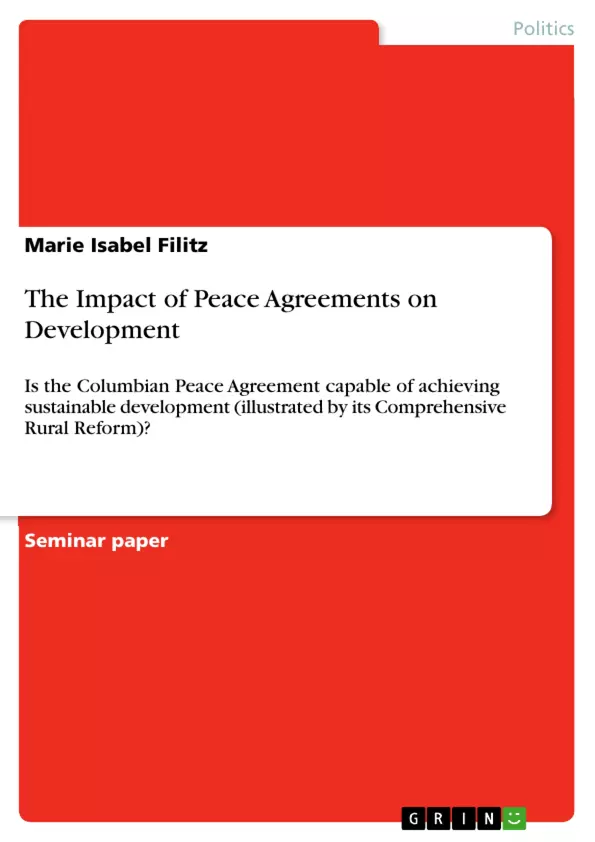For more than 50 years, Colombia has suffered a civil war that took the lives of thousands and forced millions to leave their homes. The war originated from the inequalities within the country that drove the Revolutionary Armed Forces of Colombia - People's Army (Spanish acronym FARC) to oppose the government. The FARC was formed by uprising peasants and members of the Colombian communist party and was hence strongly left-wing oriented. The government has always been positioned on the far right and was supported by various paramilitary groups. The war deepened existing inequalities and illegal groups gained significant power by means of corruption and drug trafficking.
It was only after five decades that in 2016 an agreement could be reached between the leader of the FARC and the former president of Colombia, Juan Manuel Santos. Millions of Colombians found hope in this agreement for the end of rural deprivation due to lasting peace.
But is a peace agreement capable of achieving such an outcome?
Being the oldest democracy in South America, the rule of law has existed in Colombia for a long time. Paradoxically, Colombia is known for its quite resilient constitution from 1991 and its extensive legislative framework. But previous agreements, reforms and laws have not been able to end the conflict.
Against this background, this paper intends to examine the relationship between law and development using the peace agreement as an example. The paper will focus on Chapter One of the Agreement which contains the Comprehensive Rural Reform (CRR) and attacks the root causes of the armed conflict. This is why it is the part of the Agreement most likely to achieve sustainable development.When speaking of sustainable development, I am referring to a “development that meets the needs of the present without compromising the ability of future generations to meet their own needs”.
In order to understand whether such a development can be achieved through a peace agreement, the paper is structured into four main sections. Following the introduction Colombia’s historic background will be discussed to create an understanding of current issues in the country’s development. Second, I am going to outline the content of the CRR and see whether it addresses the named problems. Section 3 shows how far the implementation process of the CRR has gone so far. In the final part I will analyze the implementation progress and explain causes for delays.
Inhaltsverzeichnis (Table of Contents)
- Introduction
- The Columbian Peace Agreement - A Step Towards Sustainable Development
- Background
- Negotiation Process and Content of the Agreement
- The Comprehensive Rural Reform as a Central Element
- The Comprehensive Rural Reform and its Impact on Sustainable Development
- The Reform's Goals and Objectives
- Land Distribution and Territorial Rights
- Economic Development and Diversification
- Social Inclusion and Participation
- Challenges and Obstacles to Implementation
- Political Instability and Conflicts
- Lack of Funding and Resources
- Corruption and Inefficiency
- Land Disputes and Resistance from Landowners
- Conclusion
Zielsetzung und Themenschwerpunkte (Objectives and Key Themes)
This work aims to examine the potential of the Columbian Peace Agreement to contribute to sustainable development, specifically focusing on the effectiveness of its Comprehensive Rural Reform. The key themes explored are: * **The relationship between peace agreements and sustainable development:** Examining how peace agreements can contribute to economic, social, and environmental sustainability. * **The Comprehensive Rural Reform:** Analyzing its objectives, implementation, and impact on land distribution, economic development, and social inclusion. * **The challenges and obstacles to implementation:** Exploring the factors hindering the successful implementation of the Comprehensive Rural Reform and the peace agreement. * **The potential for sustainable development in post-conflict Colombia:** Evaluating the possibilities for achieving long-term economic growth and social progress through the peace agreement. * **The role of international actors in supporting peacebuilding and development:** Examining the contributions of international organizations and donors in supporting the implementation of the peace agreement.Zusammenfassung der Kapitel (Chapter Summaries)
- Introduction: This chapter provides an overview of the historical context of the conflict in Colombia, outlining the key factors that led to the signing of the Peace Agreement. It also discusses the significance of sustainable development in post-conflict contexts and introduces the specific focus on the Comprehensive Rural Reform.
- The Columbian Peace Agreement - A Step Towards Sustainable Development: This chapter examines the negotiation process and content of the Peace Agreement, highlighting the key provisions relating to sustainable development. It also explores the role of the Comprehensive Rural Reform as a central element in achieving lasting peace and sustainable development.
- The Comprehensive Rural Reform and its Impact on Sustainable Development: This chapter delves into the details of the Comprehensive Rural Reform, analyzing its goals, objectives, and expected impact on land distribution, economic development, social inclusion, and participation.
- Challenges and Obstacles to Implementation: This chapter examines the challenges and obstacles that hinder the implementation of the Comprehensive Rural Reform and the peace agreement, including political instability, lack of funding, corruption, and resistance from landowners. It also discusses the potential implications of these challenges for the achievement of sustainable development.
Schlüsselwörter (Keywords)
This work explores the critical link between peace agreements and sustainable development, focusing on the Colombian context. Key themes include the Comprehensive Rural Reform, land distribution, economic development, social inclusion, and the challenges of implementing peace agreements in fragile states. Further, the analysis incorporates international cooperation, post-conflict reconstruction, and the potential impact on achieving lasting peace and prosperity.- Quote paper
- Marie Isabel Filitz (Author), 2020, The Impact of Peace Agreements on Development, Munich, GRIN Verlag, https://www.grin.com/document/955660



